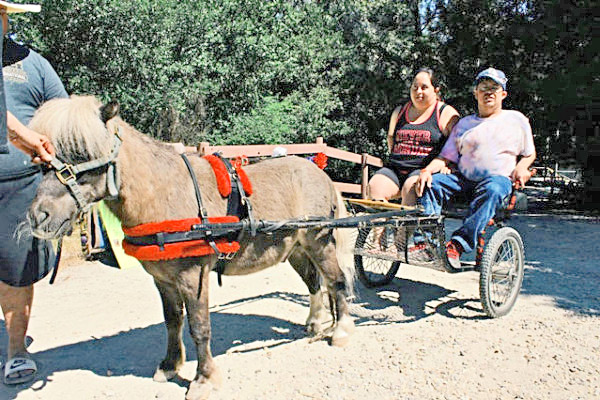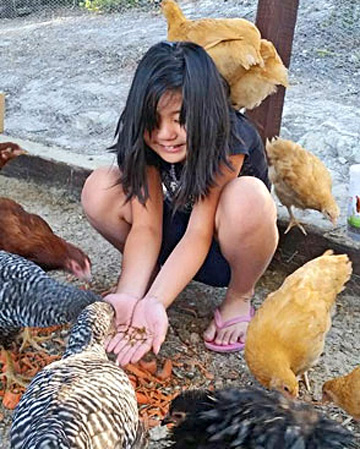Most people like animals and find friendship, fun and solace with them. The positive effect of animals have been noted particularly in the lives of those with intellectual and developmental disabilities, autism, wounded warriors, homeless and the elderly.
Published research suggests that people with autism and I/DD can benefit from exposure to dogs 1 2 3 4 5 6 7 8 9 10 11 and even that they readily establish close social relationships with dogs and other animals, in preference to people. 12 This was confirmed by an extensive survey in 2011 13and earlier in a comprehensive 2007 review of 250 AAT studies 14 Other sources claim “amazing results for autistic children”. 15 More data can be seen elsewhere at Animal Assisted Therapy Programs, Autism Assistance Dog, and the International Alliance for Animal Therapy & Healing.

At Camp Krem Yosemite, we have:
- Dogs: Toby and Moose
- Camp cats: Daisy, and an unnamed kitten
- Goats: Billy, Mac, and Poe
- Pigs: Ham Solo and Princess Leia
Our furry friends provide us with a sense of comfort and welcome cuddles and friendships! We hope to grow our furry family to reflect our Boulder Creek location which included chickens and visits from our pony friends, but for now our current therapeutic animals are enjoying all the attention.

At Camp Krem Boulder Creek, we had:
- Dogs,
- Camp cats,
- Hand-raised chicken and
- A very handsome New Zealand Kunekune pig
- Regular visits from local miniature ponies (giving campers the opportunity to groom, feed, learn about pony care, lead the friendly ponies and take carriage rides!)
These animals feature strongly in the camp-lives of many of our campers who enjoy feeding, petting and handling them.


We have discussed our program with Professor Aubrey Fine 15 of Cal Poly Pomona, a specialist in animal assisted interventions and who literally “wrote the book” on this subject (see footnotes). With his guidance, we hope to expand the program steadily.
Christina Krem, our Camp Director, was raised on New Zealand farms and has a lifetime of experience with large and small animals. She is also a qualified Veterinary Nurse and experienced dog handler and trainer who supervises the day to day operation of this program.


Resources
1 Fine, Aubrey, ed. Handbook on Animal-Assisted Therapy: Theoretical Foundations and Guidelines … Academic Press, San Diego CA, Burlington MA and London (2001)
2 Pavlides, Merope and Temple, Grandin, Animal-assisted Interventions for Individuals with Autism, Jessica Kingsley Publishers, London (2008).
3 Redefer, Laurel A. and Goodman, Joan F. “Brief Report: Pet.Facilitated Therapy With Autistic Children”, Journal of .Autism and Developmental Disorders, Vol 19, No. 3, (1989) https://asiscanblog.files.wordpress.com/2016/10/redefer.pdf
4 Martin, François and Farnum, Jennifer “Animal-Assisted Therapy for Children with Pervasive Developmental Disorders”, Western Journal of Nursing Research, 24; 657 (2002), available at http://wjn.sagepub.com/cgi/content/abstract/24/6/657
5 Prothmann, Anke; Ettrich, Christine and Prothmann, Sascha “Dogs and Objects in Children with Autism”, Anthrozoös, Vol 22, Issue 2, pp 161-171 (2009) available as reprint on request.
6 See more at https://asiscanblog.files.wordpress.com/2016/10/redefer.pdf
7 http://www.autism-spectrum-disorder.com/pettherapyandautism.html
8 Odendaal, J.S.J “Animal-assisted therapy — magic or medicine?” Journal of Psychosomatic Research, Volume 49, Issue 4, Pages 275-280 (October 2000).
9 Heimlich, Kathryn. “Animal-Assisted Therapy and the Severely Disabled Child: A Quantitative Study.” Journal of Rehabilitation 67, 4 (2001)
10 Palley, Lois, O’Rourke, and Niemi, Steven M., “Mainstreaming Animal Assisted Therapy” National Research Council Institute of Laboratory Animal Resources Journal, Vol. 51, Number 3 pp 199 – 207 (2010) at https://pubmed.ncbi.nlm.nih.gov/21131720/
11 McCoy, Krisha, “How Pet Therapy Can Help Autism: Animal-assisted therapy may increase self-confidence and other skills in children with autism” at https://earlystepscc.blogspot.com/2011/07/animal-therapy-for-children-with.html
12 Turner, Jocelyn, “Animal Assisted Therapy and Autism Intervention: A Synthesis of the Literature”, Southern Illinois University, Carbondale, May, 2011, with extensive bibliography at http://opensiuc.lib.siu.edu/cgi/viewcontent.cgi?article=1062&context=gs_rp “According to data attained from various studies, potential benefits for this population include: (a) a unique gateway for the autistic child to form relational bonds, (b) encourages attentiveness, focus, engagement in-the -moment in therapy, and (c) fosters communication, pro-social behaviors and a decrease in autistic symptoms.” (pg 49). “[R]esearch suggests …that unique benefits (ex: social communication, transition assistance, emotional regulation) may exist as a result of incorporating AAT into the program design, educational goals, and counseling sessions of educational programs.” (pp 60-61)
13 Nimer J, Lundahl B. Animal-assisted therapy: a meta-analysis. 2007;20(3):225–38, available at https://www.tandfonline.com/doi/abs/10.2752/089279307X224773
14 See more at https://www.shemakolainu.org
15 See http://www.aubreyhfine.com

